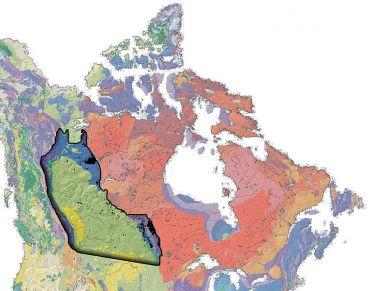Rethinking induced seismicity

Western Canadian Sedimentary Basin (outlined in black) is on a geological map of Canada. Credit: QYD
A survey of a major oil and natural gas-producing region in Western Canada suggests there may be a link between induced earthquakes and hydraulic fracturing, not just wastewater injection, according to a new report out this week in the journal Seismological Research Letters.
Hydraulic fracturing is the process of drilling and injecting fluid into the ground at a high pressure in order to fracture shale rocks to release the oil and natural gas trapped inside. That release brings the oil and natural gas up to the surface and with it comes water, chemical additives and other substances picked up during the injection process. All that fluid has to be disposed of and, often, it's reinjected underground into what's referred to as a wastewater injection well.
Across the central US, most notably in Oklahoma, it's that second part–the wastewater injection wells– that have been linked to something called induced seismicity. For years, conventional wisdom has held that these man-made tremors, which can have magnitudes of 3.8 to 4, are due to wastewater injection.
But research done by CIRES Fellow Kristy Tiampo and a team of scientists from Canada has found that while induced seismicity in Western Canada can be caused by these injection wells, a significant percentage are caused by the hydraulic fracturing itself. “These are the largest hydraulic fracturing-induced events ever seen in Western Canada,” says Tiampo. “But we're not yet sure if it's because we're looking harder, or if it's due to the geology of the region.”
Additionally, it's been thought that the more fluid you put into the ground, the larger the resulting seismic event would be. But the team's findings in Canada are disproving that trend as well. “You can get a big event from a small amount of fluid,” says Tiampo. This suggests that the size of the available fault surface that is close to its breaking point may control the maximum magnitude. As oil and gas activities continue and the area affected becomes larger, it is likely that more such earthquakes will occur, at least in some areas.
What she and the rest of the team don't yet know is if these observations are true for just this part of Canada or if they hold for all of North America. Tiampo will be looking specifically at past events in the United States to better understand why there haven't been any hydraulic fracturing-induced events and examine the possibility that there may have been some that were overlooked.
Their findings might be of interest to the oil and gas industry. The nature of the hazard from hydraulic fracturing is different that that from wastewater injection. Wastewater injection involves lateral diffusion over a broad area and long time frame, while hydraulic fracture operations employ high injection rates in a confined area, resulting in transient risks that could be compounded by multiple operations. “The safety protocols for disposal and hydraulic fracturing are based on the assumption that wastewater injection wells are responsible for larger seismic events,” explains Tiampo. “But if it turns out that hydraulic fracturing itself causes these large events, that has to be accounted for in dealing with potential hazards.”
CIRES is a partnership of NOAA and CU-Boulder.
Media Contact
All latest news from the category: Earth Sciences
Earth Sciences (also referred to as Geosciences), which deals with basic issues surrounding our planet, plays a vital role in the area of energy and raw materials supply.
Earth Sciences comprises subjects such as geology, geography, geological informatics, paleontology, mineralogy, petrography, crystallography, geophysics, geodesy, glaciology, cartography, photogrammetry, meteorology and seismology, early-warning systems, earthquake research and polar research.
Newest articles

A ‘language’ for ML models to predict nanopore properties
A large number of 2D materials like graphene can have nanopores – small holes formed by missing atoms through which foreign substances can pass. The properties of these nanopores dictate many…

Clinically validated, wearable ultrasound patch
… for continuous blood pressure monitoring. A team of researchers at the University of California San Diego has developed a new and improved wearable ultrasound patch for continuous and noninvasive…

A new puzzle piece for string theory research
Dr. Ksenia Fedosova from the Cluster of Excellence Mathematics Münster, along with an international research team, has proven a conjecture in string theory that physicists had proposed regarding certain equations….



